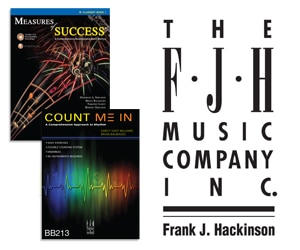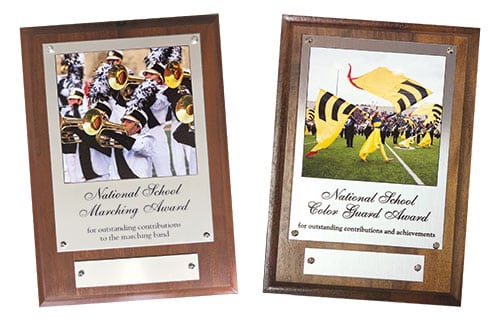As you return to the classroom, flute sectionals are an important part of the band curriculum because many students will have taken the summer off or just played through their favorite music. Of course, some will have studied privately, practiced regularly, and may even have attended a music or flute festival. Regardless, having a new set of warmups with definite goals is beneficial to all.
Here are several exercises which take only a few minutes of practice, yet build a strong foundation of musicianship, technique, and sound.
Headjoint Only: Even Air
Before playing, check the headjoint cork placement of each flute with the cleaning rod. The line at the end of the rod is positioned to be in the center of the embouchure hole. Adjust as necessary – tightening to move it to the left or unscrewing and pushing to the right. Make a note to check the cork placement at least twice a year as corks shrink over time. If you have a group of flutists playing only headjoints, the pitch will be all over the place because no manufacturer makes headjoints exactly the same length.
Have students hold the headjoint at each end with the thumbs and index fingers, and then place the embouchure plate in the chin. Have them play a low A while you may check the position of the embou-chure hole and aperture (opening in lips). The embouchure hole should be level and pointed to the ceiling. Students with a thicker bottom lip should place the embouchure plate slightly higher on the bottom lip. It is preferable that the corners of the lips are turned down; however, there are exceptions to this when a flutist has a natural smile with the lips closed.
When looking at a student’s embouchure, take note to see if the aperture (opening in the lips) is in the center of the embouchure. This is the goal unless the student has a tear drop in the center of the lips. If this is the case, then the aperture is positioned to the player’s left, slightly off center. Many of the finest players in the history of flute playing have played off-center including Marcel Moyse, Jean-Pierre Rampal, and Denis Bouriakov.
Play an A (yes, it will be out of tune) while using a tuner. The goal is to play the A while keeping the tuner needle still, not to check intonation. Once players can keep the needle still, they are using an even air stream. Since control of the air stream is the basis of all playing, having control of the speed of the air is a major component in playing musically and with a beautiful tone. It may take several attempts to achieve a still needle.
If you have students who do not blow a strong air stream, have them blow their air stream towards a children’s party pinwheel to make it spin. Once the pinwheel spins, the tone will be noticeably more vibrant. This is a quick, fun and inexpensive way to get someone to blow well.
Next, play octaves using the headjoint only. Again, it will be out of tune, but the exercise is to teach mobility of the embouchure. Alternate playing low and then high several times, first tongued, then slurred. Where the air stream touches the blowing wall is an important aspect in making a beautiful sound. The air is angled slightly down on the wall for the lower notes and up for the higher. Saying “See Sue” while letting the lips move forward teaches this concept.

Headjoint Only: Rhythm
Rhythmic reading exercises using the headjoint only is an excellent pedagogical concept to incorporate in daily practice. Start with simple rhythms such as whole notes, half notes, quarters, eighth notes, and sixteenth notes. I often use quarter coins to teach rhythm. Four quarters stacked = a whole note; two stacked = a half note; one quarter = a quarter note.

I first arrange the quarters to represent a series, but as the students catch on, I let them arrange the quarters for all of us to play. Start with one measure in 4/4, building to an eight-bar phrase. While T is the most commonly used beginning syllable, also practice using K and Hah to each note.

Assemble the Flute
Remind the students to assemble the flute with care, keeping the fingers off the keys to avoid bending of the keys. If the cork in the headjoint is in the correct place, then pull the headjoint from the body about a ¼ inch. Use a ruler to check the distance. Students like to push the headjoint all the way in because in many cases this hides the less shiny part of the tenon. Flute makers make the scale of an instrument with the headjoint pulled so the player has the option at playing higher than 440 or 442. So, pulled out a bit is actually in tune when blowing with a good air stream.
Align the headjoint and the body so there is a straight line from the center of the right-hand keys (D, E, F) through the center of the embouchure hole. To adjust the footjoint, have students place the right-hand pinkie on the D# key and then slide over so a C is easily played. This adjustment is slightly different for each flutist, as the length of the pinkie varies from one player to the next. The point is to have the right-hand pinkie be in the most natural position.
Right Hand on the Barrel:
Two Exercises
Most flutists and teachers have never experimented with playing with the right hand on the barrel, but it is one of the greatest pedagogical tools of all time. I was introduced to this technique by Michel Debost when we were team-teaching Pocatello Flute Week. He said when he had an exposed entrance in a piece while performing with the Orchestre de Paris, he always pulled the flute into his chin with his right hand while fingering a G. That way he knew that the first note would have a great attack.
When I saw him do this, I realized that flutists could also play the following two exercises utilizing only the left-hand fingered notes and their harmonics. The result of this was that the embouchure became stronger and flexible. Eventually, I compiled a bunch of melodies besides scales that could be played with the right hand on the barrel. These may be downloaded for free under Flute Archives on The Instrumentalist website. Scales that may be played in this position include chromatic, and the major scales of G, Ab, and A.
The other by-product of practicing with the right hand on the barrel is that it naturally sets the perfect position for angling the end of the flute away from the right shoulder. With the modern undercutting and overcutting, the best sounds are achieved by blowing slightly to the right of center on the wall or riser. Blowing straight across worked well when the embouchure hole in the headjoint was round, but headjoints today are made with an asymmetrical shape.
As with brass instruction, practicing harmonics is beneficial to achieving a ringing sound. Place the right hand on the barrel of the flute, crossing the right-hand above the instrument. First explore the first three notes of the harmonic series: fundamental G4, overblowing an octave to the next G5, and finally overblowing once again to D6. Tongue first, then slurring. As the flutist goes up the harmonic series, the aperture becomes smaller and the lips move forward. Practice picking out the fundamental, the 2nd partial and finally the 3rd partial in any order. Once the flutist understands where these notes are, practice slurring.

With the right hand on the barrel, practice a left-hand G major scale using the overblown harmonic notes: G5, A5, B5, C6 overblowing this same fingering sequence to achieve the next four notes of the scale. Fingering wise, the flutist plays G, A, B, C, and repeats the sequence G, A, B, C only playing these notes a 10th higher.

Students may find that tonguing these notes first is easier than slurring, but the real benefit of the exercise comes from slurring. Challenge students to play this one octave scale on one blow of air, slurred, as fast as they can. The moment when ascending from a regularly fingered note to a harmonic note is where the benefit occurs.
These exercises are simple and quick but provide an enormous benefit for developing the embouchure and thus the sound. Encourage students to compose songs that may be played with just the left hand. The results are well worth the effort.






